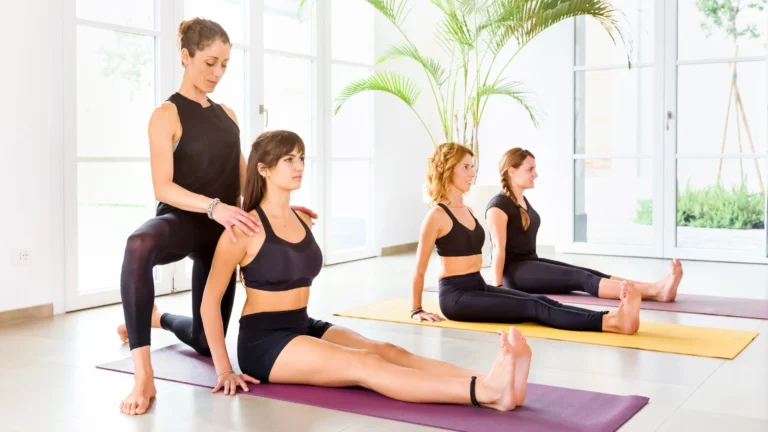What to Expect During a 200-Hour Yoga Teacher Training Course?
Embarking on a 200-hour yoga teacher training course (TTC) marks the beginning of a transformative journey into the world of yoga philosophy, practice, and teaching. Whether you are passionate about deepening your personal practice or aspiring to guide others on their yoga journey, this comprehensive guide will walk you through everything you can expect during your training.
Introduction to 200-Hour Yoga Teacher Training
A 200-hour online yoga teacher training course is widely recognized as the foundational level of certification for aspiring yoga instructors, accredited by the Yoga Alliance. It typically spans several weeks, during which participants immerse themselves in intensive study and practice under the guidance of experienced teachers.

Structure and Duration
The structure and duration of a 200-hour TTC can vary depending on the school and format chosen:
- Intensive Residential Programs: These are often held at retreat centers or ashrams, where participants live onsite for the duration of the training, fully immersed in yoga practice and study.
- Non-Residential Programs: Participants commute daily to a yoga studio or training facility, allowing for a more flexible schedule for those who may have other commitments.
The duration of the course can range from 3 to 6 weeks for full-time intensive programs, or longer for part-time options that spread over several months.
Curriculum Overview
A well-rounded 200-hour TTC curriculum covers a broad spectrum of topics essential for both personal development and teaching proficiency:
1. Yoga Philosophy and History
Foundations: Dive deep into the philosophical foundations of yoga, exploring ancient texts such as the Yoga Sutras of Patanjali, the Bhagavad Gita, and the Hatha Yoga Pradipika. Understand the fundamental principles of yoga, including the eight limbs of yoga (Ashtanga Yoga), which provide a holistic framework for personal and spiritual growth.
Ethics: Study the ethical principles of yoga, known as Yamas (restraints) and Niyamas (observances). These principles guide your conduct both on and off the mat, fostering a compassionate and mindful approach to life.
2. Anatomy and Physiology
Body Mechanics: Gain a thorough understanding of human anatomy as it relates to yoga practice. Study the skeletal, muscular, and nervous systems, learning how each system functions and how yoga postures (asanas) affect them.
Alignment Principles: Learn safe and effective alignment principles for yoga poses to prevent injuries and enhance the benefits of each posture. Understand how variations and modifications can accommodate different body types and abilities.
3. Asana Practice
Techniques: Explore a wide range of yoga asanas, from foundational poses to more advanced postures. Learn the proper alignment, benefits, contraindications, and variations of each pose, ensuring a comprehensive understanding that will support your own practice and teaching.
Personal Practice: Dedicate significant time to deepen your personal yoga practice. Through daily asana, pranayama (breath control), and meditation sessions, you will refine your skills, cultivate mindfulness, and experience the transformative power of yoga firsthand.
4. Teaching Methodology

Effective Teaching Skills: Develop essential teaching skills, including how to sequence a yoga class, provide clear and concise instructions (cueing), and create a supportive and inclusive class environment. Practice teaching your peers and receiving constructive feedback to refine your teaching style and build confidence.
Class Management: Learn practical aspects of class management, such as time management, room setup, and student interaction. Understand how to adapt your teaching approach to meet the needs of different students and class settings. To frame a checklist, Check out our blog, “ Pre-Yoga Teacher Training Checklist ”
5. Practicum
Hands-On Teaching Experience: Apply your knowledge and skills in a real-world setting through practicum sessions. Teach supervised online yoga classes to your fellow trainees, gaining valuable teaching experience and feedback from both peers and experienced instructors.
Observation and Feedback: Observe experienced teachers leading classes to learn from their teaching styles, techniques, and classroom management strategies. Use these observations to broaden your understanding of effective teaching practices and refine your own teaching approach.
Personal Growth and Transformation
1. Self-Discovery
Introspection: Expect moments of self-reflection and introspection as you explore your own yoga journey and teaching aspirations. Gain insights into your strengths, areas for growth, and personal philosophy of yoga.
Challenges: Embrace challenges that may arise during the training—physically, mentally, or emotionally—as opportunities for personal growth and transformation. Develop resilience and perseverance as you navigate through intensive study and practice.
2. Community and Support
Bonding: Form meaningful connections with fellow trainees who share your passion for yoga and personal development. The supportive environment of a TTC fosters camaraderie, mutual encouragement, and a sense of belonging within the yoga community.
Mentorship: Receive guidance and support from experienced yoga teachers who are committed to nurturing your growth as a student and future instructor. Benefit from their wisdom, expertise, and personalized feedback throughout your training journey.
Assessments and Certification
1. Examinations
Written Assessments: Demonstrate your understanding of yoga philosophy, anatomy, teaching methodology, and ethics through written examinations. These assessments ensure that you have a comprehensive grasp of the theoretical aspects of yoga.
Practical Teaching Evaluations: Showcase your teaching skills by leading supervised yoga classes during practicum sessions. Receive constructive feedback from both your peers and instructors to enhance your teaching effectiveness and confidence.
2. Certification
Yoga Alliance Certification: Upon successful completion of all coursework, examinations, and practicum requirements, you will receive a 200-hour Yoga Alliance certification. This internationally recognized credential signifies that you have met the standards for teaching yoga and allows you to pursue teaching opportunities worldwide.
Beyond the Training
1. Career Opportunities
Teaching Path: Explore diverse career opportunities as a certified yoga instructor. In India, there are approximately 5,182 yoga instructors . You may teach classes at yoga studios, fitness centers, corporate settings, retreat centers, or even start your own yoga business.
Continuing Education: Consider advancing your skills and knowledge through additional training courses, workshops, or specialized certifications. Continuing education ensures that you stay current with industry trends and deepen your expertise in specific areas of interest.
2. Personal Practice

Lifelong Journey: Understand that your journey as a yoga teacher is a lifelong commitment to personal practice, self-discovery, and ongoing learning. Maintain a regular practice of yoga, meditation, and self-care to support your well-being and sustain your passion for teaching.
Conclusion
A 200-hour yoga teacher training course is not merely a certification but a profound journey of self-discovery, learning, and growth. It equips you with the knowledge, skills, and confidence to share the transformative benefits of yoga with others while deepening your own practice. Embrace this transformative experience with an open heart and mind, knowing that it will enrich your life and empower you to make a positive impact in the lives of your future students.




